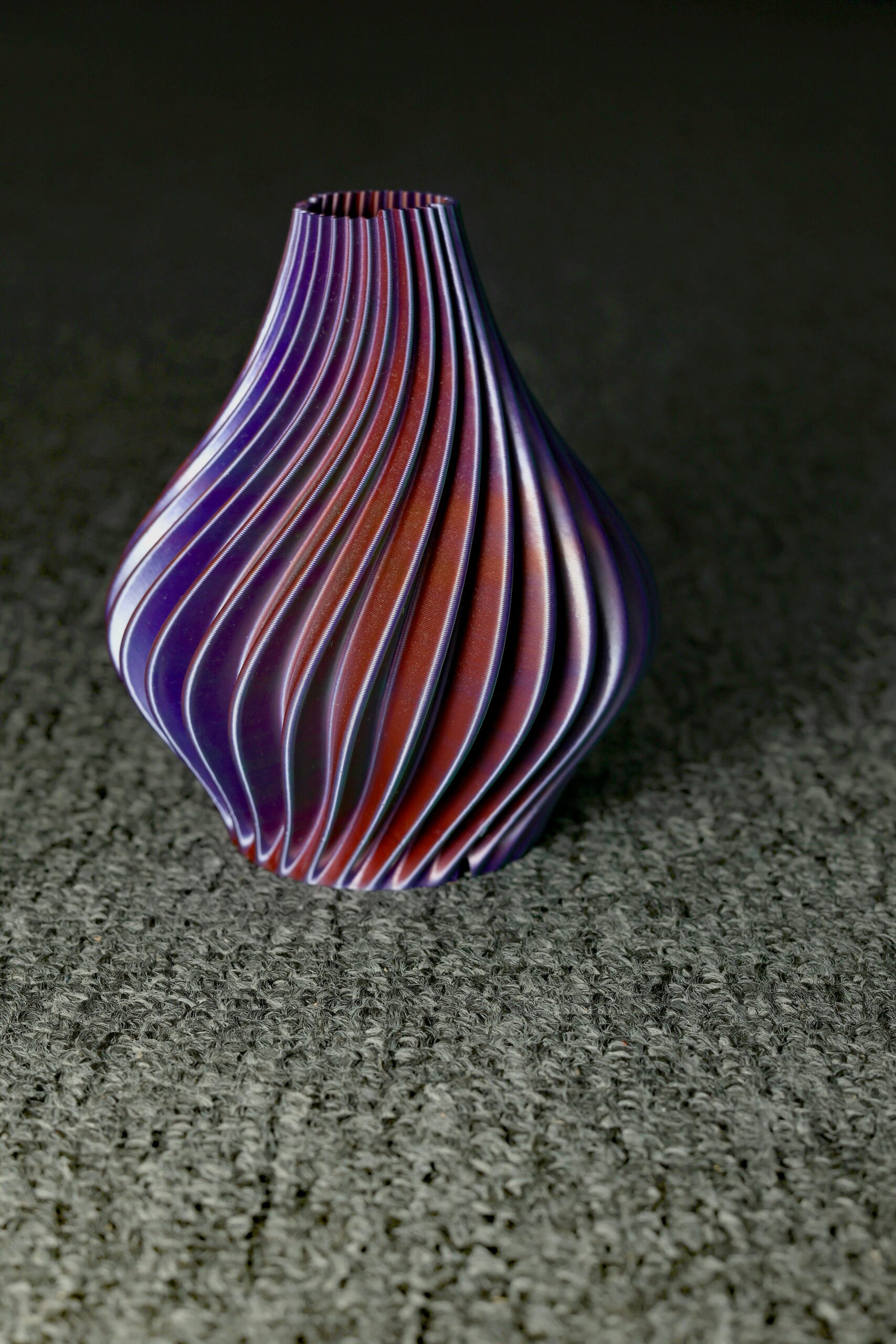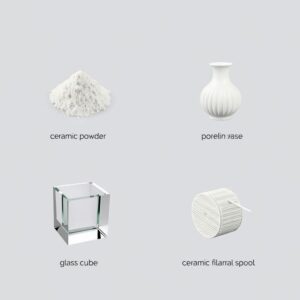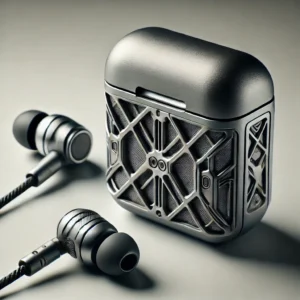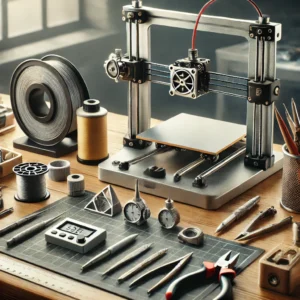Unlocking New Dimensions in 3D Printing: The Power of Ceramics, Porcelain, Glass, and Ceramic-Based Filaments

Discover the latest advancements in 3D printing materials, including ceramics, porcelain, glass, and ceramic-filled filaments. Learn about their unique properties, applications, and benefits, and explore the future of additive manufacturing and innovative applications of these materials.
3D printing, also known as additive manufacturing, has revolutionized industries across the globe. Starting with simple plastic prototypes, the technology rapidly evolved to include functional and robust materials such as metals and composites. Today, a groundbreaking advancement in the field is the incorporation of ceramics, porcelain, glass, and ceramic-based filaments. These materials offer properties that elevate 3D printing beyond prototyping and into the production of functional, high-performance components.
Ceramics and glass bring unparalleled benefits to 3D printing, including heat resistance, chemical inertness, and superior hardness—qualities that are impossible to achieve with polymers and traditional materials. The addition of porcelain extends this versatility to the realm of art and design, allowing for intricate and aesthetically pleasing creations. Ceramic-based filaments, on the other hand, allow accessibility for non-industrial users seeking to experiment with robust functionality.
These materials are unlocking new dimensions that bridge the gap between functional and decorative applications. From space exploration to personalized medical implants, glass and ceramics are being integrated into various industries as they offer both durability and flexibility. With these capabilities, 3D printing is no longer limited to small-scale models or simple household tools. Instead, it’s becoming a transformative technology for specialized fields like aerospace, architecture, and healthcare.
This article explores how the integration of ceramics, porcelain, glass, and ceramic-based filaments is redefining 3D printing. It highlights their unique properties, the innovative printing technologies enabling their use, and the growing list of industries incorporating them into everyday production processes.
The Evolution of Ceramics and Glass in 3D Printing
From Handcrafting to Digital Design
Historically, ceramics and glass were materials that required intricate handcrafting or traditional manufacturing processes. Examples such as kiln firing, casting, and glazing were time-consuming, labor-intensive, and limited in terms of design complexity. These techniques persisted for centuries because they were effective but lacked scalability, accuracy, and geometric freedom. The integration of 3D printing into ceramic and glass manufacturing has transformed these limitations into opportunities.
The use of ceramics and glass in 3D printing can be traced back to the early 2000s when researchers explored how powdered versions of these materials could be incorporated into additive manufacturing processes. While early experiments seemed promising, the challenges associated with precision, post-processing, and material compatibility slowed adoption. Since then, advancements in material science and 3D printing hardware have changed the game entirely.
Today, powdered ceramics, glass slurries, and hybrid materials are specially engineered for additive manufacturing. This evolution signifies a major leap forward, as manufacturers and artists can create complex shapes that were once impossible with traditional techniques.
Technological Innovations Driving Adoption
The shift from basic prototypes to functional ceramic and glass parts was not accidental. Significant technological breakthroughs have made it possible:
- Specialized Printing Techniques: Additive manufacturing techniques such as stereolithography (SLA) and binder jetting allow for the fine control necessary for complex ceramic or glass designs.
- Material Development: Scientists have developed highly refined ceramic powders, polymer-ceramic composites, and glass-based inks that are optimized for sintering (hardening) and improved mechanical strength.
- Advanced Slicing Software: 3D modeling tools and slicing software can now handle microscopic geometries, optimizing layer thickness and uniformity for high-resolution results.
Expanding Industry Applications
One prominent factor in the widespread adoption of ceramics and glass is their ability to strengthen the role of 3D printing in industrial-scale production. Aerospace companies use these materials to manufacture lightweight thermal shield components capable of withstanding extreme temperatures. Similarly, biocompatible ceramics are redefining healthcare with implantable medical devices that are both functional and safe for use within the human body.
Additionally, architecture and the arts have embraced these materials for their customizability and capacity to meet aesthetic and functional needs. Whether creating ornamental facades, geometric sculptures, or translucent interiors, artists no longer face the design constraints of traditional manufacturing. The ability to fabricate intricate and large-scale decorations from materials as classic as porcelain or glass emphasizes the transformative nature of these advances.
Ceramics and glass have rapidly evolved from niche materials into versatile tools of modern manufacturing. By pairing timeless aesthetics with cutting-edge technology, 3D printing offers endless possibilities across multiple industries.
What Makes Ceramics, Porcelain, and Glass Unique in 3D Printing?
Thermal Stability: Building for Extreme Conditions
One of the defining characteristics of ceramics and glass in 3D printing is their thermal stability. Unlike polymers that struggle to maintain structural integrity under heat, ceramic materials thrive under extreme conditions. For instance, silicon carbide and zirconia can withstand temperatures exceeding 1,000°C, making them suitable for applications such as jet engine components , thermal insulation panels , and spacecraft shielding .
The thermal resilience of these materials also benefits other industries requiring heat-tolerant components. Automotive manufacturers, for example, use ceramics to create exhaust nozzles and catalytic converters that perform efficiently in high-temperature environments.
Unparalleled Durability
Ceramics and porcelain are inherently hard materials, offering natural resistance to wear, corrosion, and impact. These properties make 3D-printed ceramic parts ideal for structural and mechanical applications. In the manufacturing industry, valves , pumps , and bearings printed with technical ceramics can outlast their metal counterparts thanks to their superior chemical and wear resistance.
In the healthcare world, bioceramics are gaining momentum for use in dental crowns, implants, and bone repair scaffolds. These materials combine biological compatibility with long-lasting durability, ensuring better patient outcomes.
Limitless Design Freedom With Porcelain and Glass
Porcelain and glass are excellent choices for aesthetic creations. Artists and designers leverage porcelain’s ability to be finely detailed for home décor , jewelry , and sculpture . In architectural design, glass powders can be used to create translucent panels, intricate mosaics, or light-catching ornaments, adding both beauty and functionality to modern spaces.
3D printing elevates these materials beyond mere aesthetics, enabling complex geometries that were once too fragile to produce using traditional methods. For example, glass materials crafted with 3D printing can achieve levels of transparency and optical clarity that are impossible through casting or molding alone.
Lightweight Yet Strong
While ceramics and glass are hard and dense, advancements have made it possible to incorporate lightweight latticework designs into 3D-printed components. Such designs are particularly valuable for aerospace and automotive industries, putting less strain on machinery while maintaining critical structural strength.
By combining thermal resilience, durability, aesthetic versatility, and lightweight options, ceramic and glass materials have unlocked unique opportunities in 3D printing, setting them apart from polymers and metals alike.

Types of Materials Used in Ceramic and Glass 3D Printing
Technical Ceramics
Technical ceramics, such as alumina, zirconia, and silicon carbide, offer high levels of mechanical stability, heat resistance, and wear protection. These ceramics are commonly used in aerospace , industrial machinery , and semiconductors , where material performance is critical under harsh conditions. Alumina, for example, is often deployed for insulating electrical systems due to its dielectric properties.
Porcelain and Decorative Ceramics
Porcelain slurries are specifically useful for fine art , dinnerware , and boutique design products. Liquid ceramics enable precision manufacturing, allowing for personalization in high-end industries. Porcelain’s natural glossiness and smooth finish make it the go-to material for intricate sculptures and ornaments.
Glass Powders
Glass powders optimized for 3D printing open unique opportunities in architectural and optical design. Whether creating custom light fixtures or functional lenses , printed glass offers a perfect blend of form and functionality. Standard soda-lime and borosilicate glasses ensure durability and light transmission, while engineered combinations enhance scratch resistance.
Ceramic-Based Filaments
These hybrid materials consist of ceramic particles suspended in a plastic matrix. Printed objects retain flexibility during the printing phase, which enables easier handling before sintering. This technology lowers the barrier for home and business-level users to experiment with ceramics.
The diversity in material availability caters to multiple industries, enabling customized applications based on specific property requirements.
Printing Technologies Supporting Ceramic & Glass Additive Manufacturing
1. Binder Jetting: Pioneering Ceramics and Glass
Binder Jetting has emerged as one of the leading methods for ceramic and glass 3D printing. In this technique, fine layers of powdered material (ceramic or glass) are selectively joined with a liquid binding agent, layer by layer, to create the desired shape. After completion, the “green part” is delicate and fragile but undergoes post-processing, such as sintering (firing in a kiln) or infiltrating with resins or additional materials to enhance strength, durability, and overall functionality.
What makes Binder Jetting particularly attractive is its ability to produce intricate designs at relatively high speeds with minimal material waste. The resolution is remarkably high, allowing for fine details, making it ideal for delicate porcelain products or technical ceramic parts for aerospace and medical industries. Additionally, Binder Jetting can create multi-part components in a single print cycle, further making it favorable for mass manufacturing applications.
Glass powders also thrive with Binder Jetting technology due to its ability to distribute even fine particles uniformly. The result? Transparent components with smooth textures and high optical clarity for industries like lighting, optics, and architecture.
2. Stereolithography (SLA): Enabling Micro-Level Precision
SLA, traditionally used for resin-based additive manufacturing, has been adapted to accommodate ceramic and porcelain materials in liquid slurry form. This method utilizes a UV laser to cure light-sensitive ceramic resin layer by layer, creating objects with incredible precision.
Stereolithography’s appeal lies in its ability to capture intricate geometries and fine textures , making it the gold standard for products like medical prosthetics , luxury ceramic sculptures , and dental teeth molds. Once printed, the SLA object is fired in a kiln to burn off organic resins and achieve the final hardened structure.
Porcelain artists in the luxury and decorative segments often prefer SLA due to its ability to create detailed and unique designs without complex molds or tools. The precise laser mechanics of SLA, combined with heat-based sintering, allow for seamless finishes previously unattainable with manual techniques.
3. Direct Ink Writing (DIW): Customizing Ceramic Pastes
Another advanced ceramic and glass 3D printing technique is Direct Ink Writing (DIW) . This method prints viscous ceramic or glass pastes through a nozzle in a controlled manner, similar to how frosting is applied to a cake. This extrusion process allows for exceptional flexibility in creating complex patterns such as lattice designs for lightweight structural supports or geometric shapes for architectural models.
DIW’s unique ability to combine precise mechanical control with a wide material range makes it ideal in emerging fields like bioengineering. For example, engineered lattice-like scaffolds printed with ceramic slurries can function as bone regeneration templates in medical applications, mimicking the biological structure of human anatomy.
4. Fused Deposition Modeling (FDM) with Ceramic-Based Filaments
FDM, one of the most accessible 3D printing methods, has taken on a new dimension with the introduction of ceramic-based filaments. These filaments mix ceramic particles into a polymer matrix, which makes them compatible with standard desktop 3D printers. After printing, the part is fired in a sintering kiln to remove the plastic components and densify the ceramic.
This process democratizes ceramic 3D printing, allowing hobbyists, small businesses, and educational institutions to experiment with ceramic-based creations without relying on industrial equipment. While FDM lacks the high resolution of Binder Jetting or SLA, it serves as an excellent entry point for beginners interested in unlocking ceramics’ benefits.

5. Laser-Based Glass Printing
Printing with glass requires specialized laser-based systems capable of maintaining precise heat control. Selective Laser Sintering (SLS) and Selective Laser Melting (SLM) have been adapted to work with glass powders, allowing layers of glass to fuse under high-intensity lasers. Once fused, the resulting components exhibit exceptional optical clarity , scratch resistance , and chemical durability .
Architectural firms and artists have embraced laser-based glass 3D printing to create customized windows, translucent sculptures, and intricate light fixtures. This method also finds growing potential in optics manufacturing , where precision lenses and sensors are more valuable than ever.
Applications of Ceramics, Porcelain, Glass, and Ceramic-Based Filaments
1. Aerospace: Pioneering the Frontier
Aerospace manufacturers are at the forefront of adopting ceramic 3D printing, owing to ceramics’ unparalleled thermal and mechanical properties. Components such as thermal shields, nozzles, and advanced insulation panels rely on the heat resistance of silicon carbide or zirconia. Not only do these materials survive extreme conditions, but they are also lightweight, offering significant benefits in fuel efficiency and payload capacity.
Rocket nozzles and satellite bundles printed with ceramic-based materials have already proven to withstand the conditions of space exploration. The ability to 3D print highly functional geometries reduces component weight and assembly complexity—an essential factor in the aerospace industry’s long-term sustainability goals.
2. Healthcare: Biocompatible Breakthroughs
In the medical industry, ceramic materials are enabling breakthroughs in biocompatible implants, prosthetics, and dental apparatus. Zirconia ceramics are commonly adopted for tooth crowns and custom dental implants due to their durability, chemical inertness, and compatibility with the human body.
Additionally, ceramic scaffolds for bone regeneration printed using DIW have emerged as promising medical solutions. These scaffolds replicate the natural porous structure of bones, allowing cells to regrow seamlessly. Doctors and surgeons now consider ceramic implants as practical alternatives to metals, owing to their reduced risk of rejection.
3. Consumer Goods and Beyond
From designer dining sets to intricate home décor, porcelain and ceramics have become a staple in the consumer design markets. With SLA printers, artists can create custom dinnerware, exclusive jewelry, and personalized figurines that hold unparalleled craftsmanship and precision. The polished aesthetic of ceramic is a top choice for boutique premium goods.
Similarly, glass plays a strong role in creating artistic light fixtures, beverage containers, and decorative panels. The ability to 3D print translucent glass objects with precise engraving or etching further enhances applications for both creative and functional outputs.
4. Architecture and Interior Design
Glass and porcelain have transformed the way architects approach design. Architectural firms are leveraging 3D-printed glass for planar interiors , such as translucent walls and decorative windows. Porcelain’s strength and surface finish allow architects to explore façades , tiles , and artistic elements that would have been highly labor-intensive using traditional methods.
The customization enabled by ceramic and glass 3D printing lets architects experiment freely with organic shapes , updating classical materials with modern structures that demand precision and functionality.
5. Industrial and Electronics Applications
Electronics manufacturers use 3D-printed ceramics for capacitors, semiconductors, and thermal insulators, given their properties as electrical non-conductors. Meanwhile, industries requiring high-wear components (e.g., oil and gas) create valves, pipes, and drill bits out of technical ceramic due to their toughness and erosion resistance. The shift from molded parts to 3D-printed prototypes also gives industrial engineers more control over performance testing.
The Future of Ceramic and Glass 3D Printing
As ceramic and glass 3D printing technologies grow more advanced, their adoption will expand across major industries. Emerging fields, such as renewable energy, space exploration, and eco-friendly construction, will depend heavily on strong, sustainable solutions offered by these materials. Innovations such as hybrid 3D printing, combining multiple materials in a single object, and affordable high-volume systems are expected to push the boundaries of what’s possible.
The future is undoubtedly bright for this material revolution, as industries increasingly turn to ceramics, porcelain, and glass for their unmatched properties and versatile design capabilities.
FAQs
Ceramics offer several advantages when used in 3D printing. They are known for their exceptional thermal and chemical stability , making them ideal for applications in extreme environments such as aerospace and industrial manufacturing. Ceramics are also highly durable, wear-resistant, and corrosion-resistant , ensuring long-lasting parts even under heavy mechanical or environmental stress. Additionally, 3D printing enables ceramics to be shaped into intricate and complex geometries that would be difficult, if not impossible, to achieve using traditional methods. Finally, some ceramics, such as zirconia, are biocompatible , making them suitable for medical implants and dental applications.
2. What types of 3D printing methods are used for ceramics and glass?
Several advanced 3D printing methods are used for ceramics and glass, including:
- Binder Jetting: Often used for glass powders and technical ceramics, it provides high precision and speed.
- Stereolithography (SLA): This method utilizes ceramic slurries cured with UV light, producing intricate and fine designs.
- Direct Ink Writing (DIW): This technique involves extruding ceramic or glass pastes, allowing for custom designs with lattice-like geometries.
- Fused Deposition Modeling (FDM): Using ceramic-based filaments, FDM is one of the most accessible techniques for beginners and small-scale projects.
- Selective Laser Sintering (SLS): Mainly used for glass printing, where lasers fuse powdered glass into intricate, durable designs.
Each method caters to different use cases, depending on the material’s properties and desired application.
3. What industries are benefiting the most from ceramic and glass 3D printing?
Ceramic and glass 3D printing is making waves across a wide range of industries:
- Aerospace: Lightweight and heat-resistant parts such as thermal shields and jet nozzles.
- Healthcare: Customized dental implants, biocompatible bone scaffolds, and prosthetics.
- Consumer Goods: Designer homeware, jewelry, and artistic creations.
- Architecture: Glass panels and intricate porcelain designs for façades and interiors.
- Electronics: Insulators, semiconductors, and capacitors made from technical ceramics.
These materials are valued for their unique thermal, electrical, and structural properties that polymer-based materials cannot achieve.
4. Why are thermal and chemical resistance important in ceramic 3D printing?
Thermal and chemical resistance is critical for applications in extreme environments and industries that face harsh conditions. For instance, in aerospace, engine and spacecraft components are exposed to extreme heat, sometimes exceeding 1,000°C, where metals may fail. Heat-resistant ceramics ensure optimal performance in such environments. Similarly, in industries using corrosive substances, such as chemical manufacturing or oil and gas drilling, ceramics’ chemical inertness can prevent parts from degrading over time. The integration of these benefits through 3D printing means you get durable, high-performance parts tailored to exact requirements.
5. What are ceramic-based filaments, and how do they differ from powdered ceramics?
Ceramic-based filaments are hybrid materials made by combining ceramic particles with polymer binders. These filaments are compatible with Fused Deposition Modeling (FDM) printers, making them an accessible option for hobbyists and small businesses. Unlike powdered ceramics, which require industrial-grade machines and extensive post-processing for sintering, ceramic-based filaments allow for simpler workflows. After printing, the polymer binder is burned off in a kiln, leaving behind a fully ceramic piece.
This approach makes ceramic 3D printing more accessible, although the final strength and precision may not match industrial-grade processes such as Binder Jetting or SLA printing.
6. Is it possible to create fully transparent glass objects with 3D printing?
Yes, it is possible to create transparent glass objects using technologies like Binder Jetting or Selective Laser Sintering (SLS) . However, achieving full transparency requires extremely precise control during the sintering process, as any air bubbles or impurities can affect the material’s clarity. Laser-based methods have made strides in producing custom-made optical lenses, decorative glass objects, and clear architectural components. While still a developing field, advancements in 3D glass printing are closing the gap with traditional glassblowing techniques.
7. How does post-processing work for ceramic and glass 3D-printed objects?
Post-processing plays a vital role in 3D printing with ceramics and glass to achieve the desired strength, hardness, and finish. Common post-processing steps include:
- Sintering: Heating the printed part in a kiln or furnace to burn away binders and fuse particles together, strengthening the final structure.
- Polishing: For glass, polishing ensures smooth surfaces and optical clarity.
- Infiltration: Some ceramic parts are infused with resins or metals during post-processing to improve mechanical properties.
- Glazing (Optional): For porcelain and ceramic art projects, glazing provides a decorative finish and additional durability.
While post-processing may add some time to production, it ensures the finished product meets functional and aesthetic requirements for its intended application.
8. What are the limitations of 3D printing with ceramics and glass?
Although ceramic and glass 3D printing offers unique benefits, there are some limitations:
- Fragility of Green Parts: Objects printed in their raw “green” state are fragile and require careful handling before sintering.
- Time-Intensive Post-Processing: Sintering, infiltration, and surface finishing can add significant time to the production cycle.
- High Equipment Costs: Industrial-grade machines required for Binder Jetting or SLA ceramic printing can be expensive.
- Complexity in Achieving Transparency (For Glass): Achieving perfect optical clarity in glass 3D printing requires expert-level precision and control.
Despite these limitations, ongoing advancements in material science and printing technologies are addressing these challenges to make ceramic and glass printing more scalable and efficient.
9. Can ceramic 3D printing play a role in sustainability?
Yes, ceramic 3D printing has significant potential for sustainability. The process involves less material waste compared to traditional manufacturing methods, as only the required amount of powder or filament is used for printing. Recyclable materials, such as crushed glass or reclaimed ceramic powders, can also be incorporated into the manufacturing process. Additionally, the environmental durability of ceramics means parts last longer, reducing the frequency of replacements and minimizing resource consumption over time. Industries focused on green construction and eco-friendly consumer goods have already begun adopting ceramic and glass 3D printing to promote sustainability.
10. What does the future look like for ceramics and glass in 3D printing?
The future of ceramics and glass in 3D printing looks incredibly promising, driven by both technological advancements and increased industrial demand. AI and robotics integration are speeding up production times and improving precision. Eco-friendly materials , such as biodegradable ceramic composites and recycled glass powders, are gaining traction as industries seek sustainable solutions. Meanwhile, advancements in scalability and affordability are making the technology more accessible to smaller businesses and hobbyists.
Furthermore, hybrid printing technology, which combines ceramics or glass with other materials like metals or polymers, is paving the way for multi-material components with optimized performance. Industries such as aerospace, healthcare, and construction will likely continue to lead the charge as additive manufacturing with ceramics and glass becomes firmly integrated into mainstream production workflows.
If you found this helpful, please stay tuned to our blog!!



